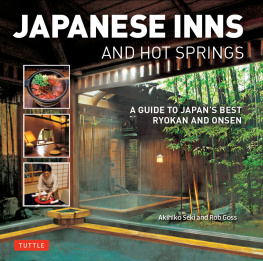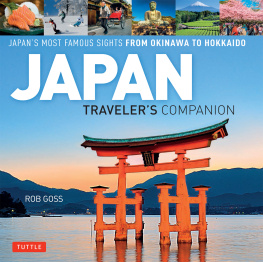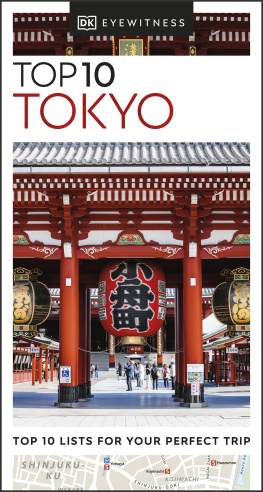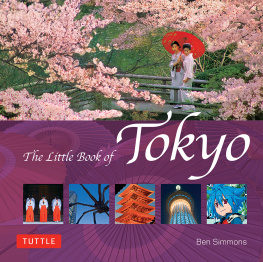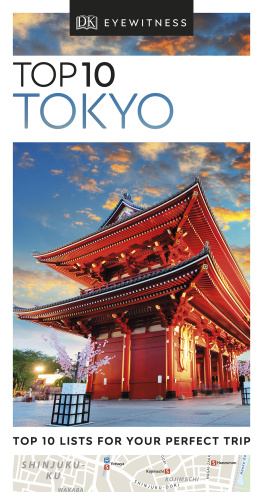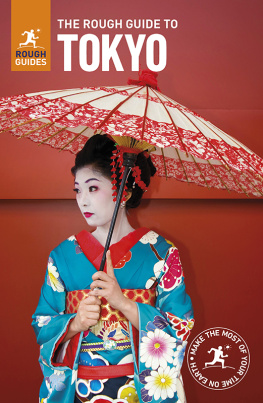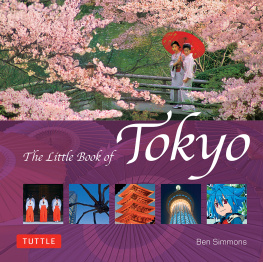
CHAPTER 1
TOKYOS
Dont Miss Sights

Tokyo Skytree towers above eastern Tokyo
Observation deck at Roppongi Hills

Cable car station at the foot of Mount Takao

Senso-ji Temple in Asakusa

Whether discovering historic temples or finding yourself hopelessly lost in translation, Tokyo offers visitors an unforgettable range of experiences and sights. The 13 listings that follow is my own selection of Tokyos Dont Miss Sights, chosen to provide a taste of all the components that come together to make a trip to Japans capital so memorable.
Meiji Jingu Shrine
Omotesanda Shopping Avenue
Tsukiji Fish Market
Tokyo Skytree
Senso-ji Temple in Asakusa
Sumida River Cruise
A Stroll Through the Yanaka District
Akihabara
Edo-Tokyo History Museum
Roppongi Hills and Tokyo Midtown
A Visit to Oedo Hot Springs in Odaiba
Shinjuku Gyoen Park
A Hike Up Mount Takao
MAKING THE MOST OF YOUR VISIT
With so many things to see and do, knowing where to start and what to explore in Tokyo is no easy task. So what to do? You could stare down jetlag on your first day by getting up bright and early for the Tsukiji Fish Market (page ) to catch a glimpse of the off-limits palace buildings and wander its landscaped outer gardens.
On your second day, you could explore the citys old east side, starting with Senso-ji Temple in Asakusa (page )an older, more down-to-earth side of Tokyo that belies the citys hectic, neon-drenched image.
On your third day, immerse yourself in central Tokyo with a stroll among the fashion-conscious throngs of Omotesando-dori and the teenyboppers of Harajuku and Shibuya, on the way stopping at the magnificent Meiji Jingu Shrine (page ).
For a fun family day out, look no further than Odaiba (page ).
As well as exploring Tokyo, also try to get out of the capital and discover some of the spectacular historical and natural sites on its doorstep. Even just a day trip out of Tokyo will give you a whole new perspective on Japan. If time is limited, get up early and have a day trip to Kamakura (page ).
If you can spare a night away from Tokyo, catch a train a couple of hours north to the World Heritage Tosho-gu shrine in Nikko (page ).

Meiji Jingu Shrine
Tradition and tranquility amid the urban sprawl
D edicated to the souls of the Emperor Meiji, the man who lead Japans transition from feudal state to modern world power in the late 19th and early 20th centuries, and his consort Empress Shoken, the quiet hush and calm of Meiji Jingu Shrine and its inner precinct (the Naien) is a perfect example of the contrasts that have come to define Tokyoof the modern city standing at ease alongside the old city and its enduring traditions. In Meiji Jingus case, this enclave of old Japan rubs shoulders with the youthful, anything-goes Harajuku area and cosmopolitan Omotesando-dori.
After passing under the first of Meiji Jingus three grand torii gateways, walking along gravel pathways shaded by the towering forest that enshrouds the main shrine, its hard to believe all this (shrine and 28-hectare/70-acre forest) was built only after the emperors death in 1912, construction eventually finishing in the fall of 1920. In fact, the buildings that are here now date only to the late 1950s when they were rebuilt after being leveled in the air raids that destroyed so much of Tokyo in 1945. Yet, regardless of age, the inner precinct is undoubtedly ancient in manner. On one visit you might see a Shinto wedding procession gracefully moving through the grounds. On another you will see people writing wishes on wood plaques and hanging them on racks in front of the main shrine, where people bow to pray, only their gentle ritual hand claps punctuating the silence.
Not surprisingly in this city of contrasts, Meiji Jingus outer precinct (the Gaien) couldnt be more different to the tranquil inner. Stretching over 32 hectares (80 acres), the Gaien is home to parkland and an incredible array of sports facilities, including the 48,000-seat National Stadium, the main venue for the 1964 Tokyo Olympics. The International Olympic Committee is always keen to talk about the Olympic legacy the games leave in each host city, and with the Gaien they have a legacy thatlike the shrine itselfhas managed to stand the test of time.
Opening Times The main shrine is open daily from sunrise to sunset. Getting There A several-minute walk from either Harajuku Station on the Yamanote Line or Meiji Jingumae on the Chiyoda Line. Contact Meiji Jingu Shrine: www.meijijingu.or.jp. Gaien: www.meijijingugaien.jp. Admission Fee Meiji Jingu Shrine is free.

Omotesando Shopping Avenue
Tokyos chicest street is defined by high fashion
I f you had to pick one place that best encapsulates chic Tokyo, this 800-meter (2,625-foot)-long zelkova-lined boulevard and the side streets that wind off of it would have to be it. Although it was originally created as an approach to Meiji Jingu Shrine (page ) in the Taisho era (191226), Omotesando-dori has become synonymous in recent years with two things: high-end shopping and modern architecture.
The area is home to the flagship stores of brands like Louis Vuitton, Prada and Dior as well as architectural master- pieces such as Tods, a slim, L-shaped building encased in an enclosure of sharply angled concrete elements and polygonal glass plates that was designed by 2013 Pritzker Prize winner Toyo Ito. Then theres Omotesandos centerpiece, Omotesando Hills, which transformed the street when it opened in 2006. Designed by acclaimed architect Tadao Ando, the 250-meter (820-foot)-long mall runs along a quarter of Omotesando-doris length. Some 100 shops and restaurants as well as 38 luxury apartments are housed on the inside, which is defined by a six-level atrium stretching three stories above ground and three below, with a spiraling ramp connecting the different levels.
Not that all the shops along Omotesando-dori fall in the high-end or high-style bracket. Opposite Omotesando Hills is the fantastic Oriental Bazaar (page ), a one-stop shop for almost every conceivable souvenir, from I Love Tokyo T-shirts to beautiful used kimono and even fine antique furniture. On a street known for its cutting-edge architecture, youve got to applaud the brashness of the bazaars faux oriental temple faade, which looks like something transplanted straight from ancient China. Like the many other mismatched buildings in Tokyo, it poses the question: just who is in charge of planning permits?
Getting There Omotesando-dori can be accessed at one end by Omotesando Station on the Chiyoda, Ginza and Hanzomon subway lines, and the other by Meiji Jingumae Station on the Chiyoda Line and Harajuku Station on the JR Yamanote Line.
Next page

